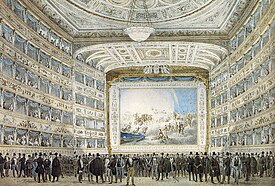La Fenice
Teatro La Fenice ("the phoenix") is an opera house in Venice, Italy. It is one of the most famous theatres in Europe, the site of many famous operatic premieres. Its name reflects its role in permitting an opera company to "rise from the ashes" despite losing the use of two theatres (to fire and legal problems respectively). (Since opening and being named La Fenice, it has twice burned and been rebuilt.)
History
In 1774, the San Benedetto Theatre, which had been Venice's leading opera house for more than forty years, burned to the ground. No sooner had it been rebuilt than a legal dispute broke out between the company managing it and the owners, the Venier family. The issue was decided in favor of the Veniers. As a result, the theatre company decided to build a new opera house of its own on the Campo San Fantin.
The construction began in June 1790, and by May 1792 the theatre was completed. It was named "La Fenice", in reference to the company's survival, first of the fire, then of the loss of its former quarters. La Fenice was inaugurated on May 16, 1792 with an opera by Giovanni Paisiello entitled I Giochi di Agrigento.
From the beginning of the 19th century, La Fenice acquired a European reputation. Rossini mounted two major productions in the theatre and Bellini had two operas premiered there. Donizetti, fresh from his triumphs in Milan and Naples, returned to Venice in 1836, after an absence of seventeen years.
In December 1836, disaster struck again when the theatre was destroyed by fire. However, it was quickly rebuilt; La Fenice once again rose from its ashes to open its doors on the evening of December 26, 1837.
Giuseppe Verdi's association with La Fenice began in 1844, with a performance of Ernani during the Carnival season. Over the next thirteen years, the premieres of Attila, Rigoletto, La Traviata and Simon Boccanegra took place there.
During the First World War, La Fenice was closed, but reopened to again become the scene of much activity, attracting many of the world's greatest singers and conductors. In 1930, the Venice Biennale initiated the First International Festival of Contemporary Music, which brought such composers as Stravinsky and Britten, and more recently Berio, Nono and Bussotti, to write for La Fenice.
On 29 January 1996, it was completely destroyed by fire. Arson was immediately suspected. In March 2001, a court in Venice found two electricians guilty of setting the fire. Enrico Carella and his cousin, Massimiliano Marchetti, appeared to have set the building ablaze because their company was facing heavy fines over delays in repair work. Carella, the company's owner, was sent to prison for seven years, while Marchetti received a six-year sentence.
After various delays, reconstruction began in earnest in 2001. In 650 days, a team of two hundred plasterers, artists, woodworkers, and other craftsman succeeded in recreating the ambience of the old theatre at a cost of some € 90 million.
La Fenice was rebuilt in 19th-century style on the basis of a design by architect Aldo Rossi. It reopened on 14 December, 2003 with an inaugural concert of Beethoven, Wagner, and Stravinsky. The first opera production was La Traviata in November, 2004. Critical response to the rebuilt La Fenice was mixed. The music critic of the rightwing paper Il Tempo, Enrico Cavalotti, was satisfied. He found the colours a bit bright but the sound good and compact. For his colleague Dino Villatico of the leftwing La Repubblica, however, the acoustics of the new hall lacked resonance and the colours were painfully bright. He found it "kitsch, a fake imitation of the past". He said that "the city should have had the nerve to build a completely new theater; Venice betrayed its innovative past by ignoring it". However, for many Venetians, a painful wound in the historical, much-admired cityscape has been healed.
See also
- John Berendt's book The City of Falling Angels centers around the fire that destroyed the Fenice Theater for the second time.

